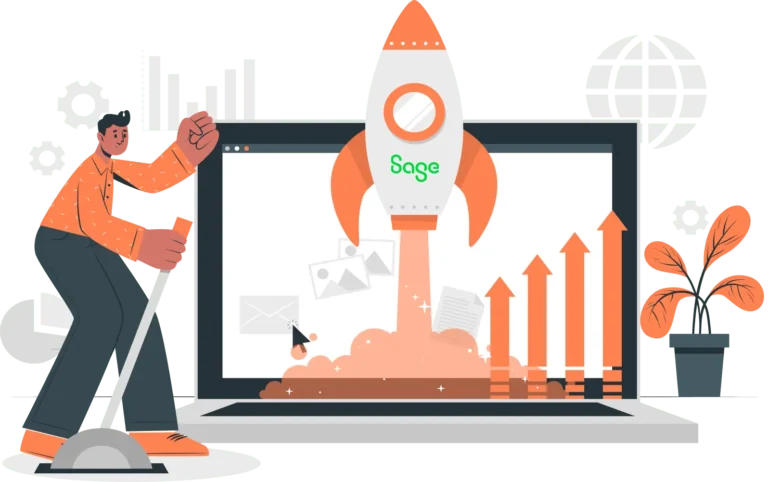- Solutions
-
-

Solutions
Perfect eCommerce solutions for any business. We provide customized solutions for B2B and B2C businesses across multiple industries.
Learn more
-
-
- Products
-
-

Products
Streamline backend operations, improve inventory management, and more with our business management software.
Learn morePLATFORM
-
-
- Services
-
-

Services
We go beyond software to provide the customizations, services, and support your business needs.
Learn more
-
-
- Industries
-
-

Industries
Business management software tailored to meet the needs of specific industries, including industry-specific regulations.
Learn moreINDUSTRIES
-
-
- Resources
-
-

Resources
Learn more about business management software and the latest developments in the industry.
Learn more
-
-

July 26, 2022
Similar to many other digital business solutions, Enterprise Resource Planning ERP systems must coexist with new technologies. Outdated ERP systems and legacy systems don’t just waste time for companies; they also inhibit growth and disrupt business operations. Although the ERP migration process is far from simple, it’s essential for allowing your company to compete and thrive in an ever-changing market. Switching to a modern ERP with better functionality also builds customer loyalty and improves customer relationships.
Data migration is often a critical, and sometimes tricky, part of an ERP implementation. This is why it’s important to have an ERP migration plan.
Every ERP system relies on a shared database at its core, which allows staff members to access the same reliable set of data throughout the company. A company needs to transfer data from existing systems into this database when applying ERP software.
What is ERP Data Migration?
ERP stands for enterprise resource planning. ERP systems gather, hold, and evaluate all data flows in one location and aid in more structured, data-based business management. This software allows a business to collect data on a variety of topics, including finances, services, supply chain management, and more. Many corporate operations are automated by ERP systems, which increases productivity and profitability. ERP software provides quick and efficient reporting, as well as in-depth analyses of internal data. Real-time data increases transparency and simplifies the decision-making process. ERPs automate and streamline business processes and resolve operational bottlenecks.
ERP migration is an intricate process of moving data from its original sources, often a legacy ERP, into the database of a recently acquired ERP system. Once your business administers an ERP solution, the data transfer is automatically ensured.
Why is Data Migration so Important to an ERP Implementation?
It is essential to ensure that the data in a new ERP platform is correct and up to date since many individuals across the company rely on it to make critical business decisions. You should also standardize your data types to ensure that data is transferred and saved in the correct format.
Outlining a precise ERP migration procedure ensures that an implementation will be successful. Planning out the ERP migration steps in advance helps to keep the process on schedule and under budget. Additionally, it provides an opportunity to remove unnecessary and outdated data that may be hiding in the company’s older systems.
The Five Types of ERP Migration
Depending on what components of your system need to be migrated (database, backend, frontend), there are five different forms of ERP migration. They all require varying amounts of time and effort. The first three types can be completed quickly and do not require user interface changes. The remaining two types of ERP migration require larger teams and investments because they are more difficult to execute. It’s important to choose the correct migration type based on your business’s needs and long-term goals.
Type 1 – Database migration.
This basic type of ERP migration does not impact your frontend or backend, and both your database solution and ERP system remain unchanged. An example of this type of migration would be relocating your database from MS SQL on-premises to MS SQL on the Cloud. You could also migrate other database types, not just SQL.
Type 2. DB migration & DB Change
This type also involves a database migration, as well as a change in the DB solution. Not only would the database move from MS SQL on-premises to the Cloud, the MS SQL would also be changed on Oracle or another type of database in this type of migration.
Type 3. Migration of DB and backend
This type of ERP migration is most suitable if you need to migrate the database with the ERP backend. As an example, this type of migration might involve migrating DB and backend from solution on-premises to the Cloud.
Type 4. ERP system migration
This type of migration involves changing your whole ERP application, such as replacing Microsoft Dynamic GP with Oracle ERP or vice versa. This type of migration usually requires new system customization, which involves additional time and expenses.
Type 5. Migration to custom ERP
This is the most difficult type of migration since it involves migrating from your current or older ERP software to a unique, custom-made solution. While it requires expensive development, the company benefits from getting a distinct solution specialized to their needs. In the long run, developing custom ERP software often pays off in the form of future growth. It also reduces or eliminates time consuming manual processes.
Which Type is Right for Your Business?
Choosing the right type of ERP migration is a vital part of a successful implementation. Having trouble choosing which type of implementation is right for your business? Never fear, ERP implementation project consultants like CertiPro are here to help. Our expert data migration team specializes in cleaning, updating, and transferring data to ensure nothing is lost during your ERP migration. We deploy ERP data migration best practices, including standardizing data and eliminating redundant or unnecessary data.

What are the Top Data Migration Challenges?
ERP data migration poses risks and challenges for business. Here are the top seven data migration challenges:
1. Data Redundancy and Integrity
Although various departments may store client or product data, this information may not be the same way across departments. Every department may categorize information differently or may use data from different sources. As an example, different departments may have different or multiple addresses for the same customer or store. They may store customer names in different formats, such as Full Name versus First Name and Last Name.
If you migrate data from every department system to your new ERP database, you may end up with issues like duplicate or inaccurate data. Data cleansing, which refers to the process of identifying and fixing data errors, is a crucial part of the ERP data migration process. It’s crucial to ensure high data integrity before you migrate your data, or your new ERP may simply replicate the problems of your old one.
2. Data Migration Costs
Data extraction, cleaning, and restriction costs might make up a significant portion of your entire ERP implementation budget. According to a report from ERP Focus, the cost of data migration alone can increase the entire cost of the new system by 10-15%.
Some companies underestimate their available resources or the cost of an ERP migration. Statistics show the ERP modernization process often takes 30% longer than anticipated and costs three times more than originally budgeted. Once more, the expert migration team will reduce this risk.
3. Stakeholder Buy-In
ERP data migration may not be at the top of the priority list for the company’s top managers. However, top-level support is essential for preventing internal conflict. As previously mentioned, different departments may have used specific systems relevant to their own business requirements, and their workers may be used to entering data in a certain way. The backing of top management can help ensure all groups work together to create a single set of data that is consistent across the business.
4. Lack of Planning and Management
Senior management must be fully involved in the ERP data migration process. Often, senior managers are the only ones who can see the full picture and what types of data automation the business will need. Their involvement makes it much easier to develop an ERP migration project plan.
5. Regulatory Issues
Regional and industry-specific regulations restrict how companies can store and use data, and it’s important for companies to adhere to these rules when migrating data. As an example, healthcare organizations must abide by HIPAA regulations that require a six-year record preservation period for certain records. Businesses that must comply with new laws like the California Consumer Protection Act and the GDPR in Europe must be able to delete all of a person’s personal data upon request.
6. Lack of Testing Activities
Fifty-one percent of businesses face operational disruptions following the modernization of their ERP software. It’s important for businesses to find and resolve all faults in their ERP system before they result in harm. This makes having clear acceptance criteria and a testing strategy an important part of the migration project.
7. Inconvenient UI/UX
In a short time, your company will have to deal with and adjust to their new technological solution. User interfaces that are confusing and difficult to use will waste time and hinder growth. Before beginning the migration process, companies should plan their UI/UX. Usability changes made after the migration process resulted in overspending in 65% of cases.
ERP Data Migration Tips & ERP Data Migration Best Practices
The most successful ERP implementations and data migrations involve careful planning, investment, stakeholder support, and knowledgeable ERP experts to guide the process.
Having a clear ERP data migration process is a key part of a successful implementation. This requires assembling an implementation team responsible for data analysis, date migration, and outcomes validation.
The migration procedure should be started early during the ERP deployment process to prevent delays. Outdated historical data should be removed as part of the migration process. Our expert team will craft an ERP data migration strategy that best serves the needs of your business. We’ll ensure that you get the data you need exactly where you need it while also eliminating redundant data to streamline performance. Following the steps outlined below will ensure a successful data migration.

5 Steps to Build an ERP Data Migration Strategy and Planning
1. Configure your new system
The first step of any data migration process is to configure your new system to handle your data. This may require setting up custom fields and workflows or more extensive customization. It’s also okay to make changes to your new system as you go through the rest of the data migration process.
2. Create a migration team
Assemble a team responsible for determining which data needs to be transferred and how to prepare it for migration. This data migration team is generally a subset of your broader ERP implementation group and should include representatives from various business units who can offer insights into how their departments use the data.
3. Analyze and map the data
Review the data in each source system, identifying any redundancies and inconsistencies. The data migration team must determine how to address these issues before importing the data into the ERP system. During this stage of the implementation, you’ll also need to map the data to the ERP database structure, enabling automated tools to import the information efficiently. Data mapping is a critical part of the data migration process.
4. Decide what data to migrate from your old ERP
Older systems may contain outdated information, such as customers who haven’t ordered in years, suppliers that are no longer in business, or data about obsolete products. They might also hold historical data on old transactions. Since much of this information may not be necessary in the new system, consider storing it offline or in a separate system, in accordance with your data retention policies.
5. Migrate, validate and test your data
Your new ERP system may offer tools to help automate data import from various systems, but you may need to first standardize the data and, in some cases, convert it into a format compatible with the ERP system. Before going live, conduct thorough tests on the migrated data for each business group and ERP application. When done properly, a new ERP implementation will improve system performance and streamline operations.
What We Can do For Your Business
At CertiPro, we’re experts in all things related to Sage ERP, including data migrations and ERP implementations. We work with both cloud based and on premise solutions. Implementing a new ERP may seem daunting, but we make it easy. Contact us today to see what our team of Sage-certified experts can do for your business.
Send us a message
Please fill out the form below and one of our associates will contact you shortly.
Training and optimization available for current Sage software

